Reinforcement fact sheet
Key Facts A1-4 per m³
CO₂ emissions: 2950.2 kg/m³
Specific weight: 7850 kg/m³
Fire protection class: A1 according to EN 13501-1; DIN 4102
Thermal conductivity: 50 W/m.ºK
-
Reinforcement is used to increase the stability of concrete (also known as reinforcement)
Increases the load-bearing capacity and resistance of the concrete to the effects of weathering
added to the liquid concrete as a solid material with a corrugated surface, steel significantly relieves the concrete and the composite material reinforced concrete is created
Absorbs both tensile stresses and compressive forces - great advantage for statics
is used in the form of reinforced concrete mats, bars or steel stirrups in various diameters of up to 40 millimeters
-
Raw materials for steel melting: scrap iron, calcium carbonate and ferroalloys
99 % scrap iron is melted down using an electric arc in a three-phase process
Sponge iron from direct reduction DRI, HBI can be used as a feedstock
The proportion of carbon in the melt must be less than 2 % to be considered steel - cast iron contains 2.1 to 7 % and steel 0.03 to 2 %
Process:
1. electric arc furnace is filled from above with the melting material scrap steel, sponge iron and then closed with a lid; there are three graphite electrodes on the lid which conduct the current and ignite an electric arc between the electrodes and the melting material
2. electrical energy is converted with high efficiency into heat of fusion - current voltage is in the kilovolt range and serves to maintain the arc; high currents in the kiloampere range provide heat
3. gas mixture between the graphite electrodes is ionized thermal energy is released by subsequent electrical gas discharge, graphite electrodes burn off in the process
4. melting material becomes liquid at approx. 1600 °C very high temperatures of up to 3,500 °C in the arc
5. in continuous casting, the molten steel is poured into a cooled, bottomless mold and solidifies in the form of a long strip of slab
6. the steel is given its shape by smoothing in rolling mills
-
High strength-to-weight ratio
Ductility, can undergo strong plastic deformation before failure High reserve strength
Predictable properties
Durability - low maintenance
is ideal for prefabrication and mass production
-
CO₂ balance according to EPD Stahl Gerlafingen AG per m³
Module A1-3 takes into account the provision of resources including transportation and production of the steel to the factory gate
Module A4 represents transportation over 200 km from the factory gate to the construction site
CO₂ emissions module A1-3: 2888.02 kg
CO₂ emissions module A4: 62.17 kg
-
Very energy-intensive & expensive to produce
Low heat storage capacity enables
Not as natural a feeling of living as wood
Shrinkage Shrinkage leads to crack development and loss of strength
Poor absorption of moisture: absorbs H₂0 slowly & then hardly releases it at all
-
CO₂ calculation according to EPD Stahl Gerlafingen AG in accordance with ISO 14067 & EN 15804+A2
Lin et al. (2019) 'State-of-the-art review on the bond properties of corroded reinforcing steel bar', Construction and Building Materials, Volume 213, 2019, Pages 216-233.
Assad, Gergess & Matar (2020) 'Effect of quality of recycled aggregates on bond strength between concrete and embedded steel reinforcement'Journal of Sustainable Cement-Based Materials, Volume 9, 2020.
Joos, Thomas (2016) Lichtbogen.
Navigant Energy Germany GmbH (2019) & Institute for Energy Economics and Rational Use of Energy 'Sector profile of the iron and steel industry' for the BMWK, Germany






